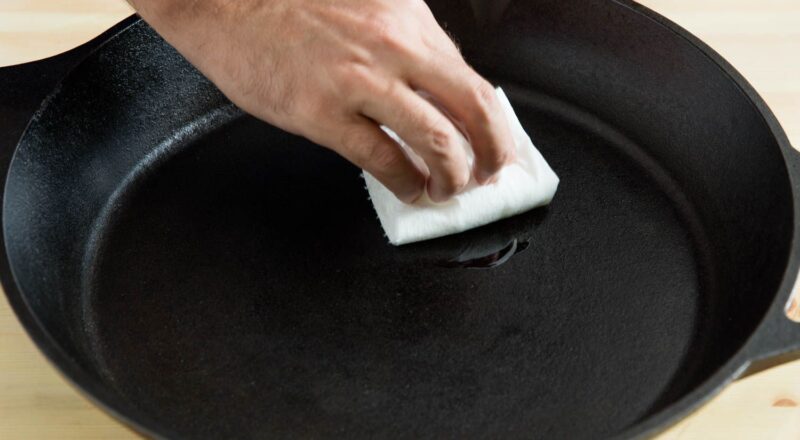Your trusty cast iron skillet is a wonderful kitchen companion, but knowing when to reseason cast iron is essential for maintaining its performance and health properties. By keeping your cast iron cookware in top shape, you can enjoy delicious, healthy meals for years.
In this comprehensive guide, we’ll delve into the signs that indicate when it’s time to reseason your cast iron, the benefits of doing so, and some valuable tips to help you get the best out of your cast iron skillet.

Importance of Reseasoning Cast Iron
Reseasoning your cast iron is crucial for several reasons. First, it helps maintain the non-stick surface, making cooking and cleaning easier. Second, a well-seasoned cast iron skillet is an eco-friendly alternative to non-stick pans with potentially harmful coatings. Lastly, maintaining the seasoning helps protect the skillet from rust and enhance its durability.
Understanding Seasoning
The seasoning on your cast iron skillet is essentially a layer of polymerized oil that forms a non-stick coating. This layer develops through repeated use and proper care. However, over time, the seasoning can wear out, making it essential to reseason the skillet periodically.

Signs It’s Time to Reseason Your Cast Iron
Knowing when to reseason cast iron involves looking out for specific signs that your skillet requires attention. Here are some indicators:
1. Food Sticking to the Surface
If food starts to stick to the surface despite using adequate oil or fat, it’s a clear sign that the seasoning has worn out. It’s time to reseason your cast iron skillet to restore its non-stick properties.
2. Rust Formation
Rust is a common enemy of cast iron. If you notice rust forming on your skillet, it’s an indication that the protective seasoning is no longer effective. Clean the rust and reseason the skillet to prevent further damage.
3. Dull or Uneven Surface
A shiny, black surface is a sign of a well-seasoned cast iron skillet. If your skillet looks dull or has an uneven coating, it’s time to reseason it to restore its original luster.
4. Strange Odors
Old, rancid oils can develop strange odors over time. If your skillet emits unpleasant smells, it’s a sign that the seasoning is deteriorating, and reseasoning is necessary.
5. Flaking or Chipping Coating
If you notice the seasoning flaking or chipping off, it’s a clear indication that the skillet needs reseasoning. A compromised coating can lead to further damage and affect the quality of your cooking.

Step-by-Step Guide to Reseasoning Your Cast Iron
Reseasoning your cast iron skillet is a straightforward process. Follow these steps to ensure optimal results:
1. Clean the Skillet
Start by thoroughly cleaning the skillet with hot water and a stiff brush. Avoid using soap, as it can strip away the seasoning. If there’s stubborn residue, use a paste of baking soda and water to scrub it off.
2. Dry Completely
After cleaning, make sure to dry the skillet completely. You can place it on a stovetop burner over low heat to evaporate any remaining moisture.
3. Apply a Thin Layer of Oil
Once the skillet is dry, apply a thin layer of vegetable oil or flaxseed oil to the entire surface, including the handle. Avoid using too much oil, as it can create a sticky residue.
4. Bake the Skillet
Place the skillet upside down in an oven preheated to 375F (190C). Place a sheet of aluminum foil on the lower rack to catch any drips. Bake the skillet for an hour, then let it cool in the oven.
5. Repeat as Needed
For the best results, repeat the oiling and baking process at least two to three times. This will help build a durable, non-stick coating.

Maintenance Tips for Your Reseasoned Cast Iron
Once you’ve reseasoned your cast iron skillet, follow these maintenance tips to keep it in top shape:
1. Avoid Soap
Refrain from using soap when cleaning your cast iron skillet. Instead, use hot water and a brush. If necessary, a paste of baking soda and water can help remove stubborn residue.
2. Dry Thoroughly
Always dry your skillet completely after washing to prevent rust. Placing it on a stovetop burner over low heat can help evaporate any remaining moisture.
3. Store Properly
Store your cast iron skillet in a dry place, and avoid stacking it with other cookware to prevent damage to the seasoning.
Health Benefits of Using Cast Iron Cookware
Using cast iron cookware offers several health benefits:
1. Reduced Chemical Exposure
Unlike non-stick pans coated with synthetic materials, cast iron is free from harmful chemicals. It provides a safer cooking surface for health-conscious individuals.
2. Improved Iron Intake
Cooking with cast iron can increase the iron content in your food, which is beneficial for those with iron deficiencies.
FAQ Section
How often should I reseason my cast iron skillet?
Avoid using soap when cleaning cast iron, and avoid cooking acidic foods like tomatoes immediately after reseasoning.
Can I use any oil for seasoning my cast iron skillet?
While you can use various oils, vegetable oil and flaxseed oil are commonly recommended for their high smoke points and effectiveness in creating a durable coating.
Why is my cast iron skillet still sticky after seasoning?
If your skillet is sticky after seasoning, it may be due to excessive oil application. Make sure to apply thin layers of oil and bake the skillet properly.
Relevant Resources
For more information on cast iron care and recipes, check out these resources:
As an Amazon Associate, I earn from qualifying purchases.

